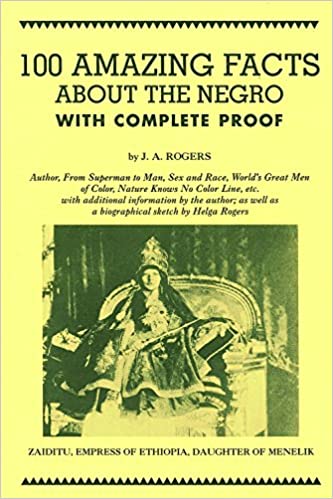Yosef A.A. (Alfredo Antonio) Ben-Jochannan (born 1918 in Ethiopia; DIED 2015---known simply as ‘Dr. Ben’ to his students and readers) is an American historian specializing in Africa.
He wrote in the Preface to this 1971 book, “In this volume facts of African history which have been for so long purposefully withheld from the public shall be revealed and carefully explained. Africa … will be seen from eyes which are different… but not least, it will not include ‘the lazy Africans who did nothing in Africa before slavery,’ and ‘developed nothing or created nothing historically’ propaganda angle of the ‘Christian missionaries.’ These age-old stereotypes racist conceptions about the Africans shall not appear in this book…
“No attempt is made to claim that this work is based on an UNBIASED presentation of the subject, as in the case of so many other works on the history and High-culture of Africa. In fact, many authors find themselves wrapped up in their own prejudices which they too often incorporate into their works… It is an honest effort to present Africa’s history, some aspects of it, from an African’s [Black man’s] point of view… but also how he sees those who are most responsible for Africa’s present deplorable conditions and the degradation which her children still suffer at the hands of Europeans and European-Americans; and most important, how a Black man and his fellow Black men view those who have been most responsible for the deliberate suppression and distortion of ‘TRUE’ African history.” (Pg. xi-xii)
In the Foreword, he clarifies, “The reader will notice that the indigenous peoples of Africa are BLACK of various shades. This is ‘TRUE,’ regardless of the names and classifications anyone gives them, just as much as DARK-SKINNED Europeans and European-Americans regardless of the names they are, or were, being called today or yesteryears. Thus: A Greek in southern Europe with his DARK SKIN is equally a European as a Swede with his BLONDE [White] skin. Equally, an indigenous BLACK-SKINNED or BROWN-SKINNED Egyptian is as much an African as a South African from any part of southern Africa---the so-called ‘BANTU’ or ‘NEGRO’---with his equally BLACK SKIN.” (Pg. xviii)
He points out, “Professor deGraft-Johnson, himself an African, has fallen for the ‘Hamitic’ and ‘Negro’ jargon within the unscientific language of his colleagues who taught him at European universities. Not only did he use the RACIST and RELIGIOUSLY BIGOTED colloquialisms common to his profession, but he also introduced another stereotype classification of the same type of terminology, namely, ‘NUBIAN RACE.’” (Pg. 32)
He summarizes, “[a] That… the Africans were involved with Europeans who were the most instrumental in making Europe what it is today; [b] that they too helped, and in many instances led, in laying the foundations for Europeans to build upon until the present … [c] that the ancient indigenous Africans were responsible for many of the basic tenets of present-day Christendom… [d] that Africans were not ‘civilized’ by anyone other than themselves…[h] that the BLACK MAN’S [the indigenous African and his descendants] in … Africa existed for as long as mankind itself exists; [i] that no amount of wishful hypotheses can change these FACTS…” (Pg. 53)
He reproduces a drawing, and explains, “The Sphinx of Gizeh as it appeared to Baron [Vivant] Denon in 1798 C.E., from one of his own drawings he made first hand. Note the relative indigenous African characteristics---nose, lips, etc. This was the way it appeared before Napoleon’s soldiers blew its face asunder in distaste of the ‘Negroid looks.’ This took place during France’s invasion of Egypt. NOTE: Why was this picture withheld from students and the general public?” (Pg. 111)
He observes, “In the final analysis it is the African or African-American and African-Caribbean [BLACK] writer who must do his or her research into the background of the hundreds of thousands of INSCRIPTIONS papyri, stone fragments, walls of tombs and temples, and other structures, in order that the pattern of the RACIST and RELIGIOUSLY BIGOTED interpretations of said INSCRIPTIONS can be edited out of future textbooks on Africa and African peoples everywhere.” (Pg. 179)
He outlines, “The following CHRONOLOGIES will also show that the formulae for the MATHEMATICAL CALCULATIONS from the NUMEROLOGICLA SYSTEM of the Osirica were first used in the planning of domestic buildings, pyramids, obelisks, stelae, layouts and surveys for engineering projects of canals and dams that were used for irrigation schemes dealing with the RISE and FALL of the Nile River, etc. They will also show that from these MASONIFIED MATHEMATICAL FORMULAE the NUMEROLOGICAL sophistication developed by these ancestors of the Africans of the Harlems of the entire world, the United States of American and ‘Western’ Europe in particular, all other MATHEMATICAL SYSTEMS known to ‘modern man’ derived their origin.” (Pg. 221) Later, he states, “‘GREEK PHILOSOPHY’ is not only a misnomer, it is a LIFE.” (Pg. 338)
He says, “The early Christian Church, which had its beginning in North Africa [Egypt] more than one hundred years before it reached Europe [Rome and Greece] in its organized institutional form, presented artifacts, drawings, statues, documents, and other artifacts in evidence which depisted the MADONNA AND CHRIST CHILD [Mary and Jesus Christ] as a BLACK woman and her BLACK child. The image of a BLACK MADONNA AND CHILD was nothing more or less than the adoption of the FERTILITY symbol of Egypt’s and Nubia’s ISIS… and HORUS.” (Pg. 375)
This book will be of great interest to those studying African history.
Black man of the Nile and his family (African-American heritage series)
$35.00
Reviewed in the United States on February 19, 2020
Format: Paperback







